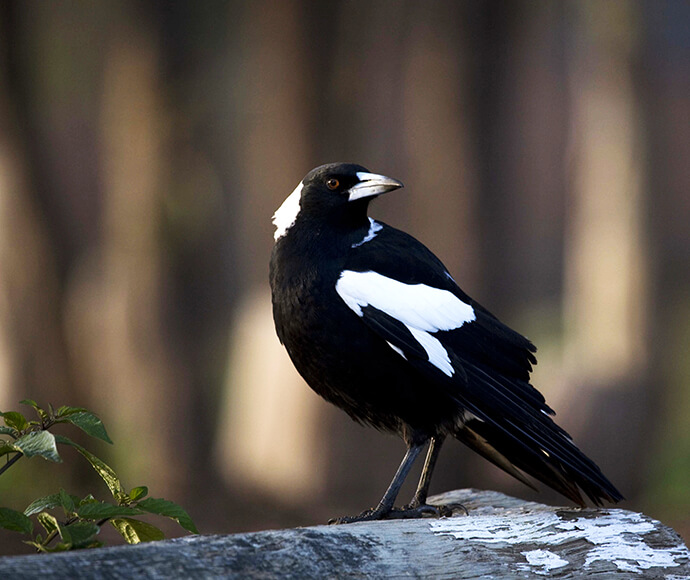What do they look like?
A magpie is easily recognised and has the following features:
- Its head, belly and tail tip are all black.
- There are splashes of white on its wings, its lower back and tail, and the back of its head.
- Its beak is blue–grey in colour.
- Its legs are black.
- Its eyes are brown.
The magpie's lack of shyness has made it popular with suburban gardeners and farmers, both for its carolling song and its appetite for insect pests.

Australian magpies are known to swoop people who enter their nesting territory.
What do they eat?
Magpies feed on small insects and animals that live on, or just under, the surface of the ground. A favourite is the scarab beetle, which is a major pest of garden lawns. Magpies will also eat frogs, small lizards, meat scraps and grain.
What do they sound like?
Magpies are one of Australia's most highly regarded songbirds. They have a wide variety of calls, many of which are complex, and their pitch may vary over up to 4 octaves. The magpie can mimic over 35 species of native and introduced bird species, as well as other animal calls, such as those of dogs and horses. Magpies have also been noted to mimic human speech when living in close proximity to humans.
When alone, a magpie will make a quiet, musical warbling noise which does not carry for long distances. Pairs of magpies often take up a loud musical calling, known as carolling, which they use to announce or defend their territory. Fledgling and juvenile magpies emit a repeated, short, high-pitched begging call. When they feel threatened, magpies will emit several high-pitched alarm calls.
Family life
Being territorial birds, up to 10 magpies will sometimes group together in a 'tribe' to defend their home. However, most territories are 'owned' by a male and female pair. A territory will have sufficiently reliable feeding and watering areas, and tall trees for shelter and nesting. Usually, there are fewer males than females in a group.
Young magpies and less successful mature birds band together in large flocks of up to several hundred birds. The areas that these birds live in are unsuitable as breeding territories because they lack permanent water or adequate food supplies. The flock must move from place to place in search of water. Individual birds in the flock will only breed and nest if they can replace a bird in a breeding territory.
Breeding
Magpies breed in their own territory, which they defend against other magpies. Nesting takes place between August and October. The female usually does all the work:
- selecting the nest site
- building the nest
- incubating the eggs – between one and 6 eggs will be incubated for around 3 weeks
- feeding the young – once hatched, the young are fed in the nest for about 4 weeks.
Within 2 years, the young magpies are forced by their parents to leave the territory. They join a group until they can gain a place in a territory as an adult breeding bird. However, many young birds die in the first months of life due to poor weather conditions, lack of food, road traffic hazards and natural predators.
Magpie attacks
For most of the year magpies are not aggressive, but for 4 to 6 weeks during nesting they will often defend their territory vigorously. People walking past may be seen as 'invaders' of the territory, prompting the magpies to fly low and fast over the person, clacking their bills as they pass overhead.
The experience of a magpie attack can be quite alarming, but it is usually only a warning. Only occasionally will a bird actually strike the intruder on the head with its beak or claws. If this unusual behaviour persists, there are ways of reducing the risk of physical injury to humans.
If a magpie swoops at you:
- Walk quickly and carefully away from the area, and avoid walking there when magpies are swooping.
- Make a temporary sign to warn other people.
- Try to keep an eye on the magpie while walking carefully away. Magpies are less likely to swoop if you look at them. Alternatively, you can draw or sew a pair of eyes onto the back of a hat and wear it when walking through the area. You can also try wearing your sunglasses on the back of your head.
- Wear a bicycle or skateboard helmet. Any sort of hat, even a hat made from an ice cream container or cardboard box, will help protect you.
- Carry an open umbrella, or a stick or small branch, above your head but do not swing it at the magpie, as this will only provoke it to attack.
- If you are riding a bicycle, get off it and wheel it quickly through the area. Your bicycle helmet will protect your head, and you can attach a tall red safety flag to your bicycle or hold a stick or branch as a deterrent.
Magpies and the law
Magpies are protected throughout New South Wales, and it is against the law to kill the birds, collect their eggs or harm their young. If you feel a magpie is a serious menace, it should be reported to your local council or the nearest NPWS office.
Protection of native animals
All native birds, reptiles, amphibians and mammals, but not including dingoes, are protected in New South Wales by the Biodiversity Conservation Act 2016.